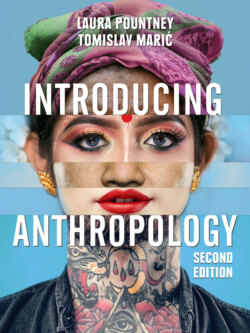Читать книгу Introducing Anthropology - Laura Pountney - Страница 20
Homo neanderthalensis
ОглавлениеTogether with early Asian people known as Denisovans, Neanderthals are our closest known ancient human relatives. In fact, everyone living outside Africa today has a small amount of Neanderthal in them. Europeans and Asians have approximately 2 per cent Neanderthal DNA. Interestingly, indigenous sub-Saharan Africans have none, or very little Neanderthal DNA because their ancestors did not migrate through Eurasia. The earliest discoveries of Homo neanderthalensis (who lived from 200,000 years ago to around 24,000 years ago) were in various parts of Europe, including Forbes’ Quarry, Gibraltar (1948), and at the Neander Valley near Düsseldorf (1856). In 2019, original DNA was extracted from the two skulls originally discovered in Gibraltar, which revealed new information about each skull – for example, one skull was male and the other was female.
One of the largest collections of fossilized bones of Homo neanderthalensis in the world was found in Croatia, at a site in Krapina, Hušnjakovo, between 1899 and 1905. The most important finding was a skull that belonged to a young, mature Neanderthal woman. This was particularly significant because of the forty-two thin cuts that were found on the frontal bone (the front part of the skull), which were made shortly after the death of the young woman, suggesting possible ritual behaviour. This information provides important evidence that Homo neanderthalensis had a developed culture.
Recent studies confirm that Homo neanderthalensis were self-conscious beings who lived socially as part of a community. They understood how to treat some illnesses and how to care for children and vulnerable groups. They were also very good hunters. The large number of the various artefacts that they made from stone for different purposes, such as scrapers, reveals much information about their technological development.
Reconstruction of a Neanderthal community based on archaeological excavations at Krapina, Croatia. (© Krapina Museum, Croatia)
STOP & THINK
If other types of early human still existed today, how do you think Homo sapiens would treat them?
Along with a team of researchers, Svante Pääbo, a leading researcher in evolutionary genetics from the Max Planck Institute, sequenced an entire Neanderthal genome, revealing the connections between Neanderthals, as well as uncovering the existence of another group of early humans, Denisovans (see below). Interestingly, genetic evidence has now conclusively confirmed that there was much more contact between Homo sapiens and Homo neanderthalensis than previously thought. Furthermore, recent findings from Gorham’s cave in Gibraltar suggest that Homo neanderthalensis survived until much later than previously suspected, up to 24,000 years ago, meaning humans and Neanderthals overlapped for longer than previously thought.
